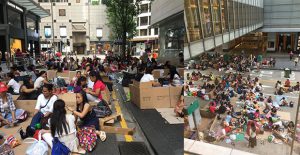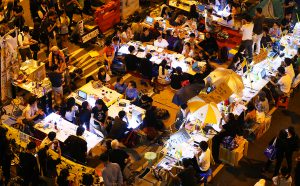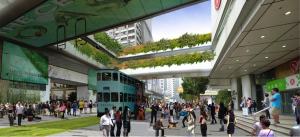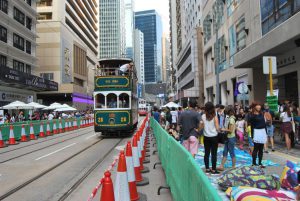|
|
[THESIS STATEMENT]
According to Hong Kong Public Space Initiative, public space can be defined as “an area where everyone, regardless of his or her background, can enter without prerequisite”1. Under this statement, good public space is always space that includes human participation and involvement”. This can be reflected on how people use the space in different natures such as pedestrianizing, leisure or demonstrating, etc. But in Central, public space is often left over because land is so limited. However, the idea of public space arises when there are temporary events. Through engaging them, we can discover the true vibrancy of the city with social, cultural and identity values.
I am looking into the devices that driven the use of public space in Central, mainly footbridges, roadside or even the roads on specific occasion. To learn from various users to develop a series of temporary prototypes that can adapt to such busy environments and address to different problems in later research. A scheme which combines various uses for multiple users in Central main traffic area is considered as a response to the tactics used by people during different events.
[WHAT]
“Tactics is a calculated action determined by the absence of a proper locus…necessary of autonomy…takes advantage of ‘opportunities’ and depends on them…a mobility that must accept the chance offerings of the moment…it creates surprises in them… in short, a tactic is an art of the weak.” – The Practice of Everyday Life, Michel de Certeau
There are more than 336,000 of them nowadays and they comprise one-tenth of our working population, working 17 hours a day from Monday to Saturday in every corner of the city. However, when it comes to Sunday, they come gathering around public places in Central and Causeway Bay. They rely on the environment, break the rules and tactically create their own corners. Central and Causeway Bay are then further characterized as “Little Manila” and “Little Indonesia” through the process of acculturation. They make themselves from invisible to visible and they create spaces which challenge Hong Kong’s capitalist value and system2. They reflect the importance of socio-cultural value of public spaces in densely-populated places.

Fig. 1 Occupy Central by domestic helpers
We often discuss temporary buildings and temporary structures for certain purposes and function. When it comes to pop-up event like the above-mentioned activities, the temporary nature is referring to the availability of the object and the feasibility of oneself to manipulate the object, to carry the object and to dispose the object. From Occupy Central (Admiralty) Movement, we can observe the creativeness of ordinary people to re-use the so-called “public” roads and turn them into study areas, churches and temples, “housing estates”, etc., with a handful of materials obtained nearby. The materials and structure are simple but the outcomes and products are efficient. Of course, they break the rules to reflect their political wills, but they also challenge the concept of public space for the people which is usually controlled by the Government and big developers.

Fig. 2 Occupy Central by local people
Why Central?
Central is the heart of Hong Kong, a Central Business District (CBD) and a physical representation of Hong Kong’s image. It represents capitalism, economy, money, efficiency, development and globalization in Hong Kong5. Public space in Central seems to be a very lavish idea.
A recent event called Very DVRC (Pedestrianizing Des Voeux Road Central) is carried out in September. It aims at providing alternative transportation option (which is walking) to reduce road transport and roadside pollution. Sadly, they can hardly challenge the conventional idea of how to use the public space due to the following points. First, there are activity booths but lack of places for streetlife. The booths are run with defined activities and people are participating but not using the space freely. Second, the rendering in proposal is tempting but the reality is disastrous. There are hundreds of traffic cones tied with police tapes just to create a boundary between event space and tramway. This can never change the deep-rooted mentality of “car first, people later” because there is still a distinction between car-road and pedestrian-road. Although the intention is good, the execution is bad. And comparing with the two occupation events mentioned before, DVRC seems to be less attractive and not successful in fully utilizing public spaces7.
 
Fig. 3 & 4 Very DVRC Rendering(left) and Reality(right)
The common fact of the three events is using public space. The difference is how to use them efficiently in such a shortage of space in Central. The nature of the events is temporary or “pop-up” and as a tactics8 to occupy public spaces. The domestic helpers and the protestors, or even the participants in Very DVRC are the “weak”. With the constant effort of making fragments to challenge the regulations, I believe the future proposals would be more successful (at least maybe for future DVRC event). This would address different classes of people and make them receive imperceptible influences towards future public space usage.
I am thinking a public space in our city centre which is heavily served with transportation networks and capital activities. And ways to “regulate” different users and programmes in such scheme of urban development.
[HOW]
Various activities are mapped during weekday and weekend.
User patterns are documented for design initiation.
Questions to be considered:
- What are the mostly required features? What is the proper scale?
- What are the problems that lead to the refusal of people using the public space?
- What is the structure? What materials should be used?
- How can the project adapt to different locations?
- How to deal with different users, e.g. workers, tourists, domestic helpers, shoppers, etc.?
- Is it sustainable in contributing in socio-cultural ideas?
Apply the research result into actual experiments.
[CITATION/BIBLIOGRAPHY]
- HKPSI, The Concepts of Public Space, http://www.hkpsi.org/eng/publicspace/concepts/
- 張小鳴, 在皇后頭上動土:菲傭在皇后像廣場的日常生活實踐, Cultural Studies@Lingnan University, Volume 8, November 2007
- 1, Source: Kwentong OFW, Life of Foreign Domestic Helpers in Hong Kong During Day Off and Holidays, http://www.kwentongofw.com/2016/07/16/life-foreign-domestic-helpers-hong-kong-day-off-holidays/, 16th July 2016
- 2 Source: SCMP, Beijing mouthpiece chides Hong Kong youth for not seizing economic opportunities, http://www.scmp.com/news/hong-kong/politics/article/1774330/beijing-mouthpiece-chides-hong-kong-youth-not-seizing?page=all&edition=hong-kong, 23rd April 2015
- 龍應台, 香港,你往哪裡去?, 2004
- 3 Source: Walk DVRC
- 4 Source: Price, David, Pedestrianising Central? Maybe leave street gatherings to the Occupy kids, Hong Kong Free Press, https://www.hongkongfp.com/2016/09/25/pedestrianising-central-maybe-leave-street-gatherings-to-the-occupy-kids/, 25th September 2016
- De Certeau, Michel, The Practice of Everyday Life – Making Do: Uses and Tactics, p.35-37
Tags: Central, city, Culture, Engagement, hijack, identity, occupy, participation, politics, Public, Social, Space, tactics, use
|




2 Comments